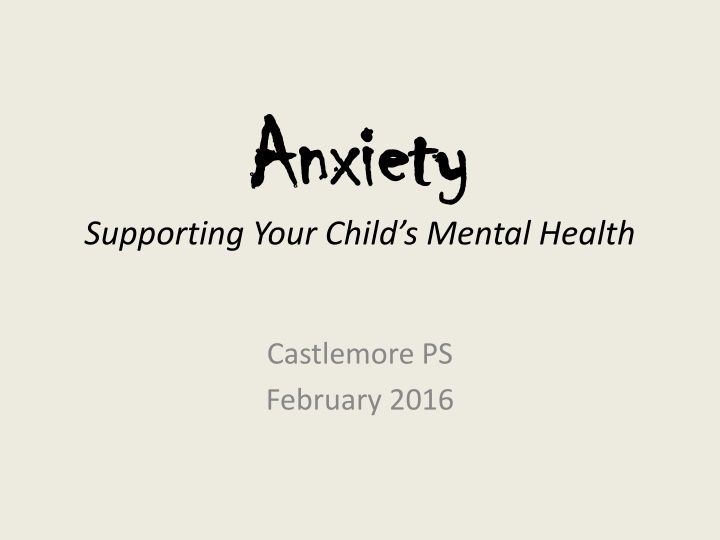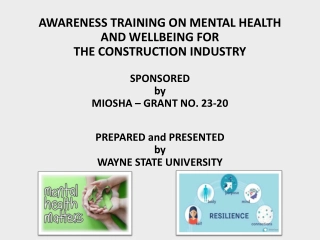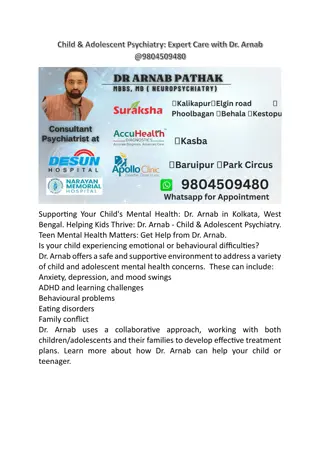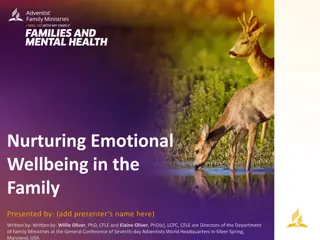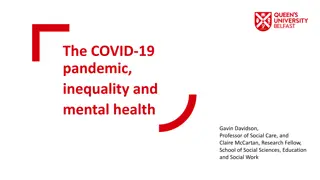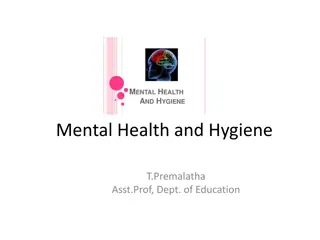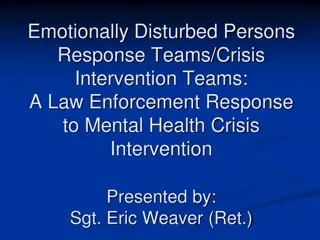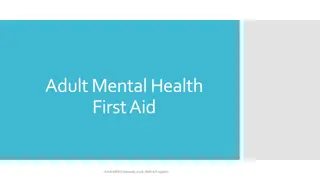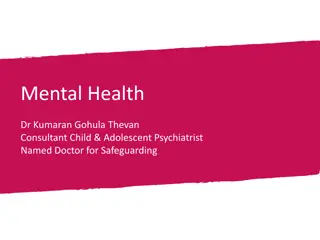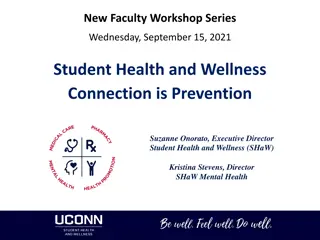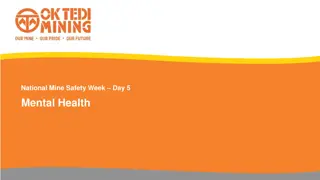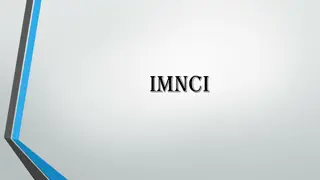Nurturing Your Child's Mental Health Journey
Valuable insights on supporting your child's mental well-being, preparing them for life's challenges, and understanding anxiety vs. fear reactions. Learn how to foster positive mental health in children to thrive in society.
Download Presentation

Please find below an Image/Link to download the presentation.
The content on the website is provided AS IS for your information and personal use only. It may not be sold, licensed, or shared on other websites without obtaining consent from the author.If you encounter any issues during the download, it is possible that the publisher has removed the file from their server.
You are allowed to download the files provided on this website for personal or commercial use, subject to the condition that they are used lawfully. All files are the property of their respective owners.
The content on the website is provided AS IS for your information and personal use only. It may not be sold, licensed, or shared on other websites without obtaining consent from the author.
E N D
Presentation Transcript
Anxiety Anxiety Supporting Your Child s Mental Health Castlemore PS February 2016
What are your hopes and dreams for your child?
How can we prepare kids for the tests of life rather than a life of tests? Linda Lantieri
Our Task as Parents and Educators To prepare our children/students to be: Ready for the post secondary and employment world Positive contributors to society Healthy and Thriving
Our Students I feel like people won t value me if I don t do well at school 32% Elem 39% Sec I usually hide my feelings of anxiety and sadness 58% Elem 64% Sec I feel like I am expected to be perfect 46% Elem 54% Sec
What do we mean when we talk about mental health?
What does a stress or anxiety reaction look like? Thoughts Something bad might happen , I am not competent , I need to be perfect , What if.. Feelings Worry, tension, fear, unsettled Behaviors Avoidance of feared situations, perfectionism, procrastination, inertia, irritability Sensations Stomach aches, sweaty palms, shakiness, dizziness, racing heart, shortness of breath, muscle tension Overestimate the threat and underestimate their ability to cope
Difference between anxiety and fear Fear Reaction caused by actual threat of danger or harm Sensible response to something potentially harmful Necessary and useful to preserve life Anxiety Similar to fear but to events or things that are either not dangerous or are much less harmful than imagined Feelings come from the anticipation of danger or that something might happen Dr. Robin Alter www.docrobin.com
When to be Concerned How to know if your child is struggling with stress, anxiety, or perfectionism F requency I ntensity D uration D evelopment
When should I worry? High anxiety Hesitancy to move outside of the comfort zone Anxiety based procrastination Hyper-competitiveness All or Nothing Thinking Dysregulated affect: high distress for perceived failures
Why Does this Happen? The Power of the Brain
Designed to keep our body in balance Our body craves homeostasis The brain supports adaptive functioning It is hardwired to protect us Often mental health issues are rooted in a neurological pattern
Why is this important? Flight, Fight, or Freeze
A Helpful Brain Model Dr. Daniel Siegel
Our starting place Negativity Bias Trauma Attachment disruption High expectations (internal or external)
Changing the Brain We need our brain to have the alarm system, we wouldn t want to turn if off BUT higher level cortical functions help us moderate it Plasticity allows us to strengthen how the brain regulates Pruning gets rid of circuits we don t use
Neither comprehension or learning can take place in an atmosphere of anxiety. Rose Kennedy
The Significance of Safe Space To learn students need to feel safe. When students don t feel safe, the fight or flight center of the brain, the amygdala, fires and incapacitates the hippocampus, the new-learning center of the brain. Students then become survivors vs. learners (Nussbaum, 2012).
How can we help? Support your child to integrate self care
.teach me HOW to calm down don t just TELL me to
Understanding the Triad S.O.S STOP .OBSERVE .SHIFT MIND Thoughts/Feelings BRAIN/BODY Behaviors Physiology
Shifting the Triad: Modifying thoughts Thoughts/Feelings
Taming the Mind Cognitive reframing Interrupt the negative pattern Retrain the pattern Car analogy automatic to manual
Shifting the Triad: Modifying Thoughts Cognitive Behavioral Therapy Changing thinking (cognition) to influence behavior Trying to judge perceived threats using a more rational scale or creating an emotional distance from certain fears/beliefs/feelings i.e. putting things in a new, more balanced perspective
Cognitive Reframing Adapted from: D. Bilsker, M. Gilbert, D. Worling & E. J. Garland Situation Thoughts Thinking Error All or Nothing Thinking Overgeneralization Disqualifying the positive Jumping to conclusions Realistic Thoughts What proof do I have? Would most people agree with this thought? If not, what would be a more realistic thought? What would I say to a friend in a similar situation?
Self Compassion Not about judging ourselves positively, but a way of relating to ourselves kindly, embracing ourselves lovingly flaws and all
Shifting the Triad: Modifying Physiology Sensation/Physiology
Strategies: Take up Smoking http://timewellness.files.wordpress.com/2011/11/deep-breathing.jpg?w=307 Just kidding! Why this works: Taking a break physically from place/environment which generates stress Deep breathing Let s practice 4, 7, 8 Breathing
Modifying Physiology/Sensation Habituation A reduction of a person s physiological response to a repeated specific stimulus We can change the way we experience a stimulus/stressor/anxiety invoking event by controlled, repeated gradual exposures Pairing NEGATIVE stimulus with a POSITIVE stimulus to retrain the brain Analogy: cold lake
Shifting the Triad: Modifying Behaviour Behaviour
Mindfulness A seated meditation may be easiest OR a body scan Seated Body Scan MARC.ucla (Mindfulness Awareness Resource Centre) meditation recordings iTunes U Guided Mindfulness (free audio guided meditations)
Modifying Actions Cycle of Avoidance/Escape This is the behavior that follows thoughts and sensations of anxiety/depression Understandable as it relieves the pressure Difficult to break but important to move towards new ways of responding (face it to erase it!) Small, measured steps in confronting this (exposure hierarchy) It will be hard to see a student in distress, be prepared you staying calm and moving forward is reassuring, sends the message there is nothing to fear Analogy-learning to ride a bike
Quit hits to support brain health The Joy List The Random Act of Kindness The Strengths List The Savoring The Social Support Squad Daily Gratitude Adapted from: http://anxietyfreechild.com/positive-psychology- guide/
Be cautious Getting too enthusiastic when a spark of progress has been made can project an energy This energy can overwhelm the student and put their brain back into alarm fight, flight or freeze
Your role in supporting your child Practice stress reduction with your child Celebrate ALL aspects of your child character, personality, school, work etc. Deliver messages of self compassion Get help if you feel their/your stress level is impacting you in ways you cannot manage
If the day ever came when we were able to accept ourselves and our children exactly as we are and they are, then, I believe we would have come to an understanding of what "good parenting" means. Fred Rogers
Are you ready to change the lens? http://www.ted.com/talks/shawn_achor_the_h appy_secret_to_better_work?language=en
The 21 day Challenge Daily: 1. Write down 3 new things you were grateful for that day 2. Journal one positive experience 3. Exercise 4. Meditation 5. One random act of kindness
Resources Websites: Parents for Children's Mental Health Anxiety BC Anxiety BC Parent Toolkit Mind Your Mind Books: Building Emotional Intelligence (Linda Lantieri) Flourish (Dr. Seligman) The Mindful Child (Susan Kaiser Greenland) Brainstorm: The Power and Purpose of the Teenage Brain (Daniel Siegal) The Highly Sensitive Child: Helping Our Children Thrive When the World Overwhelms Them (Elaine Aron) Keys to Parenting Your Anxious Child, (Dr. Katharina Manassis) Worried No More, Second Edition: Help and Hope for Anxious Children (Aureen Wagner) Freeing Your Child From Anxiety, (Tamar Chansky) Helping Your Anxious Child (Ronald M. Rapee)
